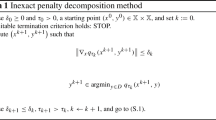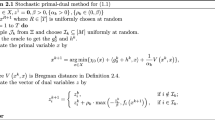Abstract
We consider well-known decomposition techniques for multistage stochastic programming and a new scheme based on normal solutions for stabilizing iterates during the solution process. The given algorithms combine ideas from finite perturbation of convex programs and level bundle methods to regularize the so-called forward step of these decomposition methods. Numerical experiments on a hydrothermal scheduling problem indicate that our algorithms are competitive with the state-of-the-art approaches such as multistage regularized decomposition, nested decomposition and stochastic dual dynamic programming.





Similar content being viewed by others
Notes
Note that \({{\bar{x}}}_3(\xi ^a_{[3]})={{\bar{x}}}_3(\xi ^b_{[3]})=\bar{x}_3(\xi ^c_{[3]})\) and \({{\bar{x}}}_3(\xi ^d_{[3]})=\bar{x}_3(\xi ^e_{[3]})\).
Although the regularization effect still presents if (8) has multiple solutions.
References
Asamov, T., Powell, W.B.: Regularized decomposition of high-dimensional multistage stochastic programs with markov uncertainty. SIAM J. Optim. 28(1), 575–595 (2018)
Bank, B., Guddat, J., Klatte, D., Kummer, B., Tammer, K.: Non-linear Parametric Optimization. Birkhäuser, Basel (1982)
Ben-Tal, A., Nemirovski, A.: Non-euclidean restricted memory level method for large-scale convex optimization. Math. Program. 102(3), 407–456 (2005)
Birge, J.R.: Decomposition and partitioning methods for multistage stochastic linear programs. Oper. Res. 33(5), 989–1007 (1985)
Chen, Z.L., Powell, W.B.: Convergent cutting-plane and partial-sampling algorithm for multistage stochastic linear programs with recourse. J. Optim. Theory Appl. 102(3), 497–524 (1999)
Clark, D.I., Osborne, M.R.: A descent algorithm for minimizing polyhedral convex functions. SIAM J. Sci. Stat. Comput. 4(4), 757–786 (1983)
de Matos, V.L., Morton, D.P., Finardi, E.C.: Assessing policy quality in a multistage stochastic program for long-term hydrothermal scheduling. Ann. Oper. Res. 253, 713–731 (2016)
de Oliveira, W.: Target radius methods for nonsmooth convex optimization. Oper. Res. Lett. 45(6), 659–664 (2017)
de Oliveira, W., Sagastizábal, C.: Level bundle methods for oracles with on demand accuracy. Optim. Methods Softw. 29(6), 1180–1209 (2014)
de Oliveira, W., Sagastizábal, C., Jardim Penna, D.D., Maceira, M.E.P., Damázio, J .M.: Optimal scenario tree reduction for stochastic streamflows in power generation planning problems. Optim. Methods Softw. 25(6), 917–936 (2010)
de Oliveira, W., Sagastizábal, C.A., Scheimberg, S.: Inexact bundle methods for two-stage stochastic programming. SIAM J. Optim. 21(2), 517–544 (2011)
de Oliveira, W., Solodov, M.: A doubly stabilized bundle method for nonsmooth convex optimization. Math. Program. 156(1), 125–159 (2016)
de Oliveira, W., Sagastizábal, C., Lemaréchal, C.: Convex proximal bundle methods in depth: a unified analysis for inexact oracles. Math. Prog. Ser. B 148, 241–277 (2014)
de Queiroz, Anderson Rodrigo, Morton, David P: Sharing cuts under aggregated forecasts when decomposing multi-stage stochastic programs. Oper. Res. Lett. 41(3), 311–316 (2013)
Donohue, C., Birge, J.R.: The abridged nested decomposition method for multistage stochastic linear programs with relatively complete recourse. Algorithmic Oper. Res. 1(1), 20–30 (2006)
Dupačová, J., Polívka, J.: Asset-liability management for Czech pension funds using stochastic programming. Ann. Oper. Res. 165(1), 5–28 (2009)
Dupačová, J.: Portfolio Optimization and Risk Management via Stochastic Programming. Osaka University Press, Osaka (2009)
Fábián, C.I.: Bundle-type methods for inexact data. In: Proceedings of the XXIV Hungarian Operations Researc Conference (Veszprém, 1999). Special issue, T. Csendes and T. Rapcsák (eds.), vol. 8, pp. 35–55, (2000)
Ferris, M.C., Mangasarian, O.L.: Finite perturbation of convex programs. Appl. Math. Optim. 23(1), 263–273 (1991)
Fhoula, B., Hajji, A., Rekik, M.: Stochastic dual dynamic programming for transportation planning under demand uncertainty. In: 2013 International Conference on Advanced Logistics and Transport, pp. 550–555, May (2013)
Girardeau, P., Leclere, V., Philpott, A.B.: On the convergence of decomposition methods for multistage stochastic convex programs. Math. Oper. Res. 40(1), 130–145 (2014)
Goel, V., Grossmann, I.E.: A stochastic programming approach to planning of offshore gas field developments under uncertainty in reserves. Comput. Chem. Eng. 28(8), 1409–1429 (2004)
Herer, Y.T., Tzur, M., Yücesan, E.: The multilocation transshipment problem. IIE Trans. 38(3), 185–200 (2006)
Higle, J.L., Sen, S.: Stochastic decomposition: an algorithm for two-stage linear programs with recourse. Math. Oper. Res. 16(3), 650–669 (1991)
Hindsberger, M., Philpott, A.B.: Resa: A method for solving multi-stage stochastic linear programs. In: SPIX Stochastic Programming Symposium, Berlin (2001)
Holmes, D.: A (po)rtable (s)tochastic programming (t)est (s)et (posts). http://users.iems.northwestern.edu/~jrbirge/html/dholmes/post.html (1995)
Homem de Mello, T., de Matos, V.L., Finardi, E.C.: Sampling strategies and stopping criteria for stochastic dual dynamic programming: a case study in long-term hydrothermal scheduling. Energy Syst. 2(1), 1–31 (2011)
Homem de Mello, T., Pagnoncelli, B.: Risk aversion in multistage stochastic programming: a modeling and algorithmic perspective. Eur. J. Oper. Res. 249, 188–199 (2016)
Kelley, J.E.: The cutting-plane method for solving convex programs. J. Soc. Ind. Appl. Math. 8(4), 703–712 (1960)
Kiwiel, K.C.: Finding normal solutions in piecewise linear programming. Appl. Math. Optim. 32(3), 235–254 (1995)
Kiwiel, K.C.: Proximal level bundle methods for convex nondifferentiable optimization, saddle-point problems and variational inequalities. Math. Program. 69(1), 89–109 (1995)
Lemaréchal, C.: An extension of davidon methods to nondifferentiable problems. Math. Program. Study 3, 95–109 (1975)
Lemaréchal, C.: Constructing bundle methods for convex optimization. In: Hiriart-Urruty, J. B. (ed.) Fermat Days 85: Mathematics for Optimization. North-Holland Mathematics Studies, vol. 129, pp. 201–240. North-Holland (1986)
Lemaréchal, C., Nemirovskii, A., Nesterov, Y.: New variants of bundle methods. Math. Program. 69(1), 111–147 (1995)
Linowsky, K., Philpott, A.B.: On the convergence of sampling-based decomposition algorithms for multistage stochastic programs. J. Optim. Theory Appl. 125(2), 349–366 (2005)
Maceira, M.E.P., Terry, L.A., Costa, F.S., Damázio, J.M., Melo, A.C.G.: Chain of optimization models for setting the energy dispatch and spot price in the Brazilian system. In: Proceedings of the 14th Power Systems Computation Conference—PSCC, pp. 1–7. Servilla, Spain (2002)
Morton, D.P.: Stopping rules for a class of sampling-based stochastic programming algorithms. Oper. Res. 46(5), 710–718 (1998)
Nesterov, Y.: Introductory Lectures on Convex Optimization. A Basic Course. Applied Optimization, vol. 87. Springer, Berlin (2004)
Pereira, M.V., Granville, S., Fampa, M.H.C., Dix, R., Barroso, L.A.: Strategic bidding under uncertainty: a binary expansion approach. IEEE Trans. Power Syst. 11(1), 180–188 (2005)
Pereira, M.V.F., Pinto, L.M.V.G.: Multi-stage stochastic optimization applied to energy planning. Math. Program. 52(2), 359–375 (1991)
Ch Pflug, G., Römisch, W.: Modeling. Measuring and Managing Risk. World Scientific, Singapore (2007). https://www.worldscientific.com/worldscibooks/10.1142/6478
Philpott, A.B., de Matos, V.L.: Dynamic sampling algorithms for multi-stage stochastic programs with risk aversion. Eur. J. Oper. Res. 218(2), 470–483 (2012)
Philpott, A.B., Guan, Z.: On the convergence of stochastic dual dynamic programming and related methods. Oper. Res. Lett. 36(4), 450–455 (2008)
Rebennack, S.: Combining sampling-based and scenario-based nested benders decomposition methods: application to stochastic dual dynamic programming. Math. Program. 156(1), 343–389 (2016)
Ruszczyński, A.: On the regularized decomposition method for stochastic programming problems. In: Marti, K., Kall, P. (eds.) Stochastic Programming: Numerical Techniques and Engineering Applications, pp. 93–108. Springer, Berlin (1995)
Sen, S., Zhou, Z.: Multistage stochastic decomposition: a bridge between stochastic programming and approximate dynamic programming. SIAM J. Optim. 24(1), 127–153 (2014)
Shapiro, A.: Analysis of stochastic dual dynamic programming method. Eur. J. Oper. Res. 209, 63–72 (2011)
Shapiro, A., Dentcheva, D., Ruszczyński, A.: Lectures on stochastic programming. Modeling and Theory. MPS-SIAM Series on Optimization. SIAM and MPS, vol. 9. Philadelphia, (2009)
Shapiro, A., Tekaya, W., da Costa, J.P., Soares, M.P.: Risk neutral and risk averse stochastic dual dynamic programming method. Eur. J. Oper. Res. 224(2), 375–391 (2013)
van Ackooij, W., de Oliveira, W., Song, Y.: An adaptive partition-based level decomposition for solving two-stage stochastic programs with fixed recourse. Inf. J. Comput. 30(1), 57–70 (2018)
van Ackooij, W., Frangioni, A., de Oliveira, W.: Inexact stabilized Benders’ decomposition approaches: with application to chance-constrained problems with finite support. Comput. Optim. Appl. 65(3), 637–669 (2016)
van Ackooij, W., Lebbe, N., Malick, J.: Regularized decomposition of large-scale block-structured robust optimization problems. Comput. Manag. Sci. 14(3), 393–421 (2017)
Wolf, C., Fábián, C .I., Koberstein, A., Stuhl, L.: Applying oracles of on-demand accuracy in two-stage stochastic programming. A computational study. J. Oper. Res. 239(2), 437–448 (2014)
Wolf, C., Koberstein, A.: Dynamic sequencing and cut consolidation for the parallel hybrid-cut nested L-shaped method. Eur. J. Oper. Res. 230(1), 143–156 (2013)
Acknowledgements
We would like to acknowledge the coordinating editor and two anonymous referees for their constructive suggestions that considerably improved the original version of this article. We also thank C. Wolf and A. Koberstein for providing us with some test problems and E. Finardi and F. Beltrán for the instances of the multistage hydro-thermal power generation planning problem. Finally, the first and the second authors would like to acknowledge the partial financial support of PGMO (Gaspard Monge Program for Optimization and operations research) of the Hadamard Mathematics Foundation, through the project “Models for planning energy investment under uncertainty”. The third author acknowledges partial support by the National Science Foundation (NSF) under grant CMMI 1854960. Any opinions, findings, and conclusions or recommendations expressed in this material are those of the authors and do not necessarily reflect the views of the NSF.
Author information
Authors and Affiliations
Corresponding author
Additional information
Publisher's Note
Springer Nature remains neutral with regard to jurisdictional claims in published maps and institutional affiliations.
Appendices
Appendix A: Proof of Lemma 1
-
Item (a)
Let \({{\tilde{x}}}\) be a solution of (11), then \(f({{\tilde{x}}}) \le f(x(\tau ))\) (recall that both \({{\tilde{x}}}\) and \(x(\tau )\) belong to X). Moreover, \(f( x(\tau ))+ \frac{1}{\tau }\varphi (x(\tau )) \le f( {{\tilde{x}}})+ \frac{1}{\tau }\varphi ({{\tilde{x}}})\). These two inequalities show that \(\varphi (x(\tau )) \le \varphi (\tilde{x})=\varphi ^*<\infty \).
-
Item (b)
The previous item ensures that \(\varphi (x(\tau _k)) \le \varphi ({{\tilde{x}}})< \infty \) for all k. Since \(\varphi \) is a strong convex function, its level sets are compact. As a result, \(\{x(\tau _k)\}\) is a bounded sequence and, therefore, there exists a constant \(L<\infty \) bounding all subgradients of \(\varphi \) at \(x(\tau _k)\) for all k.
-
Item (c)
We first prove that
$$\begin{aligned} \varphi (x(\tau '))< \varphi (x(\tau '')) \text{ and } f(x(\tau '))<f(x(\tau '')) \hbox { for all } 0<\tau '<\tau ''. \end{aligned}$$(29)
It follows from optimality of \(x(\tau ')\) and \(x(\tau '')\) and strongly convexity of \(\varphi \) that
By summing these inequalities we obtain \(\varphi (x(\tau '))\left( \frac{1}{\tau '} - \frac{1}{\tau ''}\right) < \varphi (x(\tau ''))\left( \frac{1}{\tau '} - \frac{1}{\tau ''}\right) \), showing that \(\varphi (x(\tau ')) < \varphi (x(\tau ''))\). Inequality (30) implies \( f(x(\tau '')) - f(x(\tau '))< \frac{1}{\tau ''}[\varphi (x(\tau ')) - \varphi (x(\tau ''))] < 0\), yielding \(f(x(\tau '')) < f(x(\tau '))\).
Next we show that
To this end, let \(x \in X\) such that \(x\ne x(\tau )\). Then \(\frac{1}{\tau }[\varphi (x(\tau )) - \varphi (x)] < f(x) -f(x(\tau ))\) from the definition of \(x(\tau )\). If \(\varphi (x) \le \varphi (x(\tau ))\) then \(f(x(\tau ))< f(x)\), showing that \(x(\tau )\) is the unique solution of \(\min \{ f(x)\; \text{ s.t. } x \in X,\; \varphi (x) \le \varphi (x(\tau ))\}\). Furthermore, if \(f(x)\le f(x(\tau ))\), then \(\varphi (x(\tau )) < \varphi (x)\), showing that \(x(\tau )\) is the unique solution of \(\min \{ \varphi (x)\; \text{ s.t. } x \in X,\; f(x) \le f(x(\tau ))\}\).
We are now in position to proof item (c). Recall that \(\varphi (x(\tau )) \le \varphi ({{\tilde{x}}})\) from item (a). The equivalences follow from (31) \( \varphi ({{\tilde{x}}})= \varphi (x(\tau )) \Leftrightarrow f({{\tilde{x}}})= f(x(\tau )) \Leftrightarrow x(\tau ) \in X^* \), and the identity \(x(\tau ')=\tilde{x}\) for all \(\tau ' \ge \tau \) follows from (29). \(\square \)
Appendix B: Detailed descriptions of the test instances
We describe the test instances used in our numerical experiments in more detail. The interconnected network structure of the hydrothermal power plants in Brazil is depicted in Fig. 6, and the detailed data on hydro and thermo plants are given in Table 4 and Table 5, respectively. In addition, we set the demand to be a constant 14,500 in each stage, and we set the unit penalty cost of not satisfying the demand to be 4500. The scenario data file is too big to be displayed here, but will be available upon request.
Rights and permissions
About this article
Cite this article
van Ackooij, W., de Oliveira, W. & Song, Y. On level regularization with normal solutions in decomposition methods for multistage stochastic programming problems. Comput Optim Appl 74, 1–42 (2019). https://doi.org/10.1007/s10589-019-00104-x
Received:
Published:
Issue Date:
DOI: https://doi.org/10.1007/s10589-019-00104-x





